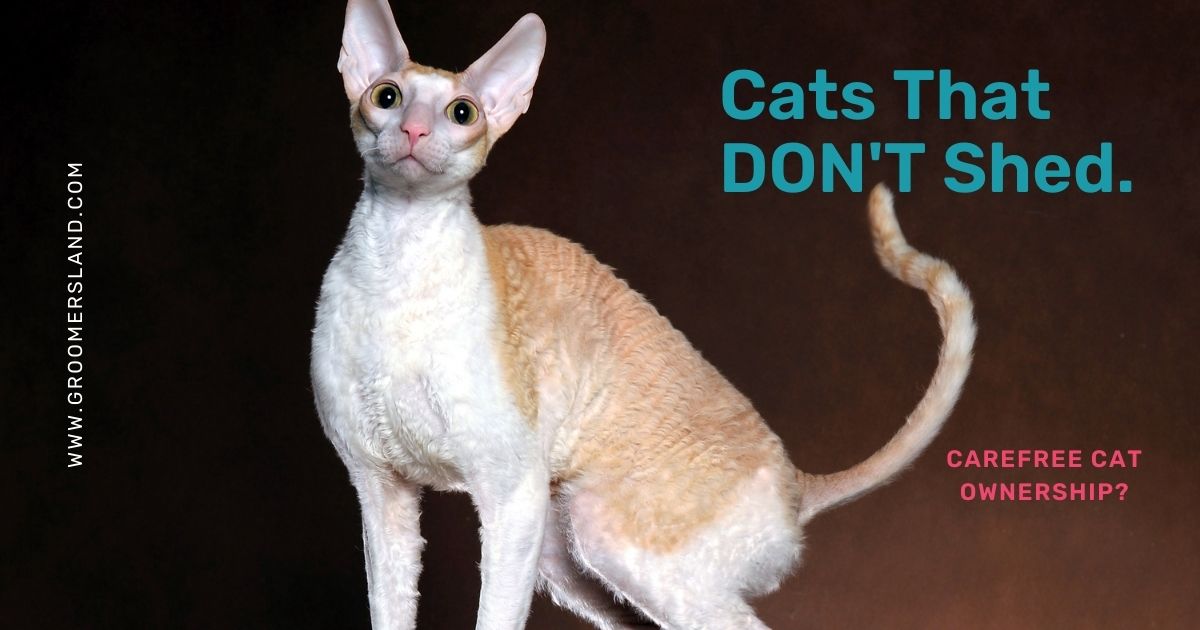No Shed Cats? Are you Fur-Real?
Have you ever had to deal with pet hair? Are you wondering if there are cats that don’t shed? Well, cats are great for keeping the house clean, but that also means they leave their own little messes behind.
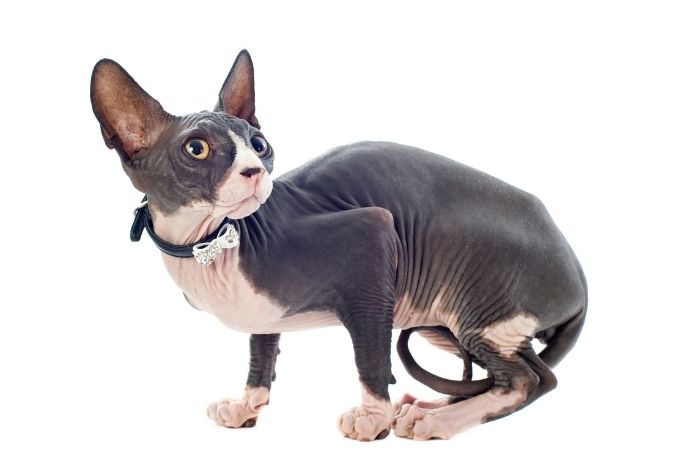
If your living space is already covered in fur after just one visit from Fido (or Fluffy!), then this article might be able to help! There are 21 different breeds of cats out there that shed less than other types.
How Are Hypoallergenic Cats Even Possible?
Regrettably, there are no hypoallergenic cat breeds. This is because cats have two allergenic proteins, including Del d1 and Fel d4. Moreover, these two are created in the cats’ saliva and submandibular salivary glands and their sebaceous glands in the skin. So in this sense, because all cats have saliva and these glands, they all produce these proteins.
Vet experts state that these proteins are usually deposited on your cat’s hair during grooming. Therefore, they claim that many pet owners blame the hair while the real culprit is the saliva. Because of this, you can hardly come across a truly hypoallergenic cat. This is true even for hairless cat breeds because they create allergens in their skin and saliva.
Moreover, the allergens also gather on your carpet, wall, and clothes. ENT specialists argue that the tiniest amount of these allergens can lead to a reaction from people who suffer from allergies.
However, they also agree that you may experience fewer allergy symptoms around low shedding cats. This is because cats that don’t shed much do not spread as many allergens around your home through contaminated saliva.
If you’ve had a history of allergic reactions to cats and still want one, it might be worth looking into hairless cat breeds or ones that don’t shed as often. All the breeds below are perfect for people who want to keep their outfits tidy and stay allergy-free. They may be just what you’ve been looking for!
Cat Breeds That Don’t Shed (or Rather, Sheds Less)
Sphynx
The Sphynx cat is a naturally hairless creature that was created via mutation and has been the choice of many people who want to lessen their allergies. These skin-less felines typically only have a bit of fur on their nose and perhaps some peach fuzz-like fur. However, this doesn’t mean you don’t need any attention when taking care of your pet!
Teresa Keiger of The Cat Fanciers’ Association claims that all cats excrete oil on their skin just like humans. However, since the Sphynx does not have a coat to absorb the oil, you will likely find it where the cat likes to relax.
In this regard, she advises pet parents to wipe their Sphynx’s body to help reduce the oil. Nevertheless, this cat breed makes the best cuddle partners.
Siberian
A distinguishing feature of the Siberian cat is its long and furry coat. But, despite the fluffy fur, they shed less than many other breeds, making them hypoallergenic. They are also known to grow large and can be aggressive despite their size.
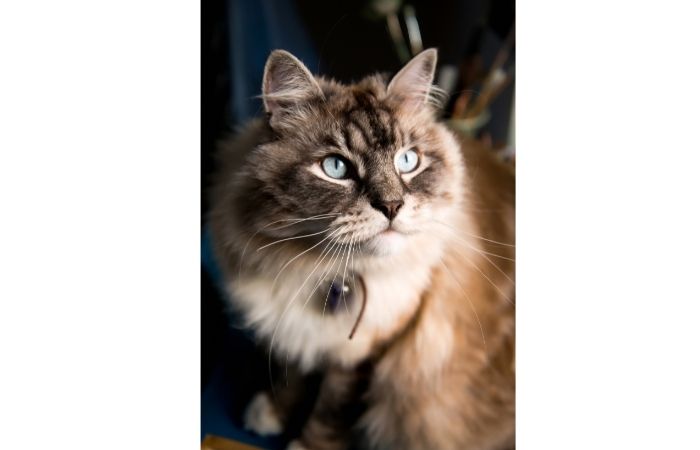
However, the excess fluff needs thorough grooming and weekly brushing. Therefore, if you go for this low-shedding cat breed, you should be ready to maintain it.
Lykoi
The Lykoi has an exciting mix of traits. They can be affectionately compared to the werewolf because their coat has this sparse texture, but Keiger notes that these cats do not shed all year round, but they molt their coats a few times.
The intelligence and playfulness are what really sets them apart. Some of its parts, such as the face, are bare. All these traits qualify the Lykoi as one of the cat breeds that don’t shed much.
Cornish Rex
The Cornish Rex is a cat breed with hair so short and curly; it’s hard to believe this furry feline could ever shed. But, according to Keiger, the best thing about the Cornish Rex is its playfulness! This active pet would love nothing more than an owner or two for whom they can romp around together in their spare time (and there are plenty).
Devon Rex
The Devon Rex is a popular breed with people who want to curl up and take it easy. Unfortunately, they develop an insistent attention-seeking behavior, often demanding more than you can give them in return for their love of human companionship; however, this might not be such a bad thing because these critters know how much we enjoy giving into. Our furkids’ demands!
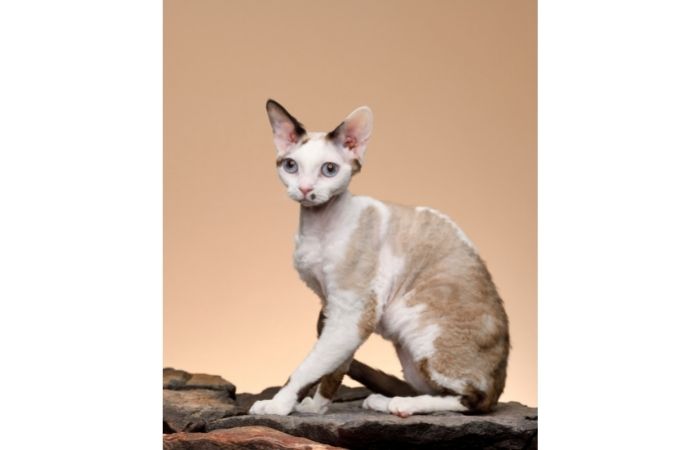
However, all the love and cuddling means you’ll have more hair, saliva, and allergens on your clothes. As a result, you should be careful if you are extremely sensitive.
Bengal
The Bengal cat breed comes with a unique coat similar to its non-domesticated counterparts like the leopard. Fortunately, it makes the list of cats that don’t shed much because their eye-catching fur sheds less. Moreover, it requires less maintenance.
Even though it has a rugged appearance, the Bengal is exceedingly friendly and social. Additionally, they are very active and vocal, so pet parents need to offer them enough space to explore and speak out.
Burmese
The Burmese is a relatively smaller cat having a short and finer coat that naturally sheds less hair than other breeds. The Cat Fanciers’ Association claims that this cat breed has a lot of love for its owners. They prefer spending more time by their side as much as they can. However, they are not overly demanding.

Birman
We bet you were thinking to yourself, “while this breed’s coat is fabulous, I can’t picture my house covered in it!” Well, don’t worry because Hope Gonano says the opposite. She deems the Birman as having one of the lowest shedding rates among all breeds! So, if you are looking for low-shedding cats, this is an ideal choice.
Additionally, Birman cats are intelligent, curious, and affectionate by nature. They require very little grooming as their non-matting coat requires minimal maintenance to keep it looking sleek and shiny. As a result, Birmans can adapt quickly to living with children and other pets in the home.
Russian Blue
The Russian Blue cats are among the cat breeds that shed the least. For instance, it is believed that the Russian Blues usually shed over a two to a three-week period up bi-annually. Additionally, Gonano claims that they are easy to groom.
The Russian Blue’s hair stands out at a 45-degree angle that you can trace patterns into it, and they would remain until you smooth them out. The Russian Blue is a breed with an elegant, muscular build and gentle temperament. They’re known to be easy to train as well!
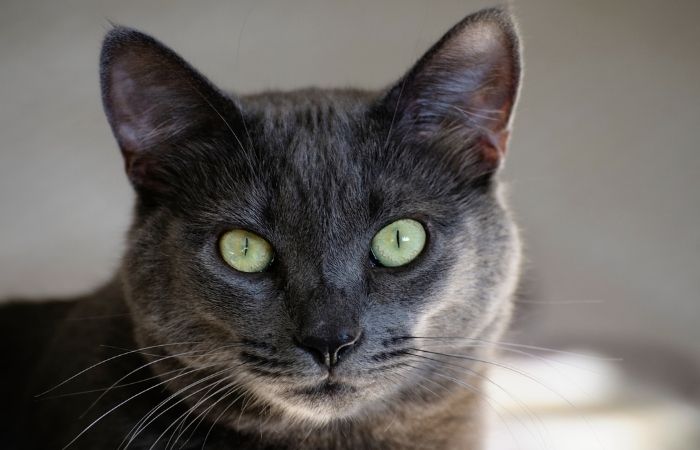
Exotic Shorthair
The Exotic Shorthair is also known as the Short-haired Persian. It has a thick and dense coat that sheds minimally, making it a part of the nonshedding cat community. According to Gonano, the Exotic Shorthair needs some combing to get rid of any dead hair.
Nevertheless, it is regarded as a calm, relaxed cat breed that is friendly and adapts quickly to different living conditions, including country and apartment living. In this regard, it is an ideal option for individuals interested in cat breeds that don’t shed.
Siamese
The Siamese is an excellent option for pet parents looking for a cat breed with a low-maintenance coat. For example, Gonano claims that you can effortlessly care for this cat by brushing with a fine-tooth comb. Once you comb off the dead hair, the Siamese sheds minimally.

Other distinctive features of the Siamese include its large ears, unique blue eyes, and elegant, slim figure. Moreover, this cat breed comes in different colors such as lilac point, seal, chocolate, and blue. The Siamese also loves being around its owners.
Oriental Shorthair
If you’re looking for a highly social kitty who needs attention, the Oriental Shorthair is your go-to cat. These cats are similar in many ways to their Siamese counterparts but have distinct differences as well!
For example, these felines can come with over 300 color patterns and more than just one pattern on their body – they range from ebony black up through pure white or bi-color combinations that include tabby stripes running across them.
The loving nature of this breed makes it easy to keep tabs on. However, when left alone too much, the Oriental Shorthair becomes sensitive. Therefore, ensure you give this cat breed the attention it deserves.
How to Manage Your Allergies
According to the American College of Allergy, Asthma & Immunology, the best way to manage your allergies to cats is to avoid them. But what if you can’t just stay away from these snuggly animals?
Well, if you are one of these, there is excellent news for you! There are certain things you can do to deal with the side effects. For instance, cat allergy treatment is readily available in the form of antihistamines.
However, since there are multiple antihistamines, you should seek the counsel of an allergist to help you determine the one that would work best for you.
Here are other things you can do to lessen the effects of cat allergies:
- Always wash your hands after petting or playing with your cat.
- Use a lint roller to get rid of excess hair from clothes.
- Ensure you vacuum (with a pet hair remover vacuum cleaner) and dust your home often to remove excess hair.
- It would help if you also considered using a HEPA (High-Efficiency Particulate Air) grade filter in your vacuum. These are specially designed to capture and filter particularly fine particles.
- Keep your cat groomed and bathed regularly to reduce loose hair and dander.
How to Prevent Your Cat From Shedding
It is an open secret that pet parents love their feline friends but not their molting. Even if you go for cat breeds that shed the least, you still need several tips on how to prevent your cat from shedding its hair.
Here are some notable tips:
Brush Your Cat Regularly
This is arguably, the most effective way for pet parents to reduce their cat shedding hair. Brushing helps to collect the fur before it falls off. Therefore, you should consider your cat’s coat before deciding the brush you’ll use and how often you should brush.
Change Your Cat’s Diet
Your cat should eat a balanced diet rich in Omega to maintain a healthy coat. For example, consider cat food that has a balanced ratio of 3 fatty acids and omega 6. These critical elements help to promote a healthy coat and prevent shedding.
Suppose you are not sure you should seek the counsel of your vet on the best diet to feed your cat to improve its coat health. Additionally, you can join online cat communities where you can share opinions with other cat parents.
Keep Your Cat Hydrated
It is apparent that cats that don’t drink enough water usually have dry skin and coats. These coat conditions result in the molting of their hair. In this sense, you should ensure you keep your cat’s bowl full to the brim with fresh, clean, and cool water to drink. Hydrated cats have a shiny coat, which all pet parents are looking for, right?
Give Them Their “Cat Corner”
If everything else fails, give your cat a special place where it can cover in cat hair instead of your sofa and bed. For instance, place a comfortable bed where your feline friend can enjoy sleeping. This approach will help you to keep any excess hair contained.
Conclusion
While no cat is truly hypoallergenic, people who both love and are allergic to cats might still be able to get a furry friend by choosing the right breed. For example, you can go for no-shed cats or cats that don’t shed much. Moreover, you can also use the tips shared in this piece to reduce your cat’s shedding.
Consider your allergies before getting one, though; consult with an allergist if needed! You can choose from the ones shared in this piece, and you will be snuggling with your feline friend sooner rather than later.

